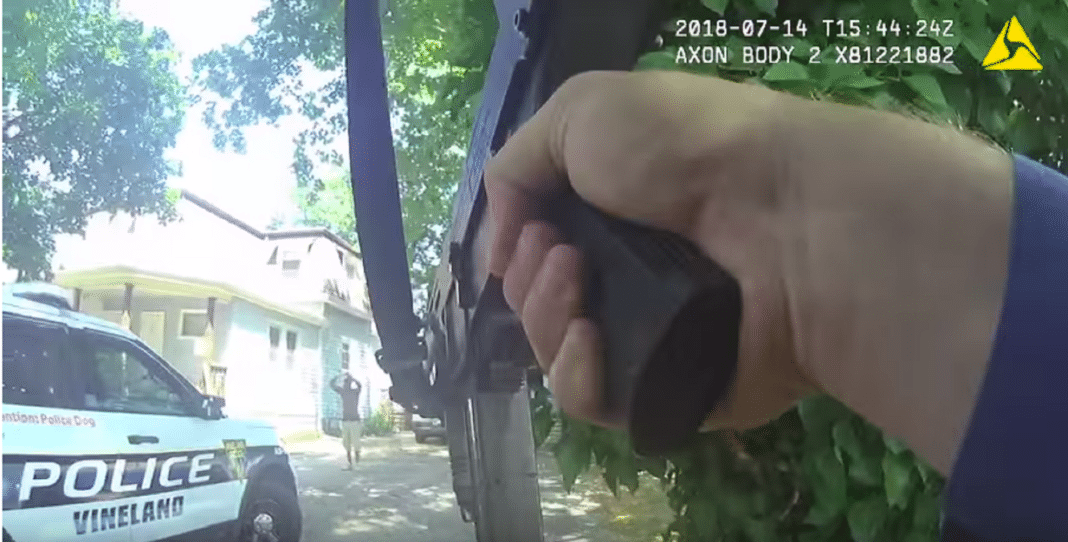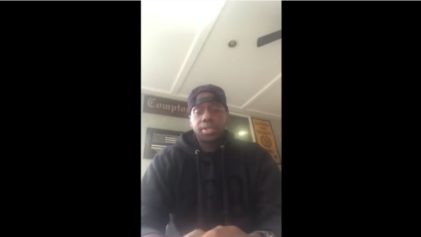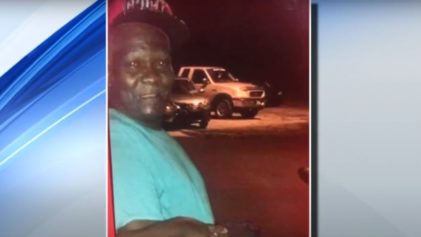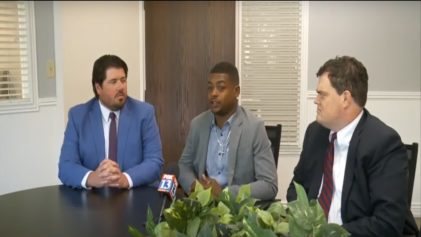
On July 14, 2018, Vineland, N.J., police fatally shot Rashaun Washington, 37, a father of two, following a 911 call. Washington, who was unarmed, reportedly struggled with mental illness. This latest incident purs a spotlight on the killing of Black people with mental health challenges who come in contact with law enforcement. (photo: YouTube)
Two demographic groups in America that face a disproportionate risk of death at the hands of police are Black people and those who are living with mental illness. Black people who live with mental illness face a double risk in a nation that stigmatizes both blackness and mental illness. This in a system where police are not held accountable and are encouraged by the courts to shoot first and think later.
The recent police killing of Rashaun Washington of Bridgeton, New Jersey, is a case in point. The 37-year-old Washington, a father of two who reportedly was struggling with mental illness, was shot to death by an unnamed Vineland, New Jersey, police officer on July 14. Washington — who was recovering from drug dependency and working after recently being released from a halfway house — sat on someone’s porch, took off his shirt, and refused to leave, prompting the occupant of the house to call the police.
Prosecutors claim Washington had garden shears wrapped in a shirt, which witnesses say was a water bottle. When officers arrived, Washington mentioned his girlfriend had left him, telling police, “You’re going to have to blow my brains out,” and “I don’t want to be here no more.” He also told officers he was holding an explosive device. One of the officers shot Washington three times with what was apparently a semiautomatic rifle, after which he fell to the ground, a police dog attacked him, and an officer pepper sprayed Washington. Police released bodycam footage of the killing. The unidentified officer was placed on administrative leave, and Cumberland County prosecutors have initiated an investigation.
Walter Hudson Sr., founder and chairman of the South Jersey-based National Awareness Alliance, is demanding “justice and accountability” for Rashaun Washington — including the release of the name of the officer who killed him — and calling for the local prosecutor to relinquish the investigation to the New Jersey state attorney general. Hudson, who said the county prosecutor, Jennifer McCrae, “will work as a criminal defense attorney to exonerate the officer” rather than seek justice, has urged State Senate President Stephen Sweeney to present Gov. Phil Murphy with Senate Bill S1036 (A3115), which would mandate that the state attorney general’s office oversee cases involving deaths caused by law enforcement. Another bill, S2469 — which would call for an independent prosecutor in the attorney general’s office to oversee cases such as the killing of Rashaun Washington — passed the state legislature but was “pocket vetoed” by former Gov. Chris Christie, who took no action on the legislation as he left office.
“My contentions still remain the same, Mr. Rashaun Washington should not be dead,” Hudson said in a statement to Atlanta Black Star, noting that while police took white supremacist Dylann Roof to Burger King after he committed mass murder in the Mother Emanuel AME Church in Charleston, an unarmed Black man such as Rashaun Washington is shot three times.
“After viewing the video release by the Cumberland County Prosecutor’s Office, there were still other non-lethal deescalating alternatives the Vineland Police Officer could have used, to subdue Mr. Washington. Why did the officers use mace? If the officer(s) thought Mr. Washington had a so-called bomb, why not call in the bomb-squad? Why would the officer risk his other co-workers’ lives shooting Mr. Washington, if in fact, there was a bomb?” Hudson added.
I hope I don’t get killed tomorrow because a cop thinks my water bottle is a bomb #RashaunWashington
This Is Black Amerikkka
— Walter L. Hudson Sr. (@Activist30) July 17, 2018
Still won’t speak to #RashaunWashington https://t.co/HFrqCQcc7c
— Walter L. Hudson Sr. (@Activist30) July 26, 2018
Rashaun Washington becomes part of a longstanding pattern of Black people with mental health challenges whose interactions with law enforcement result in their death.
Earlier this year, Houston police killed Danny Ray Thomas, a Black man who was unarmed and whose pants were down. The man suffered from depression, and his two children had drowned in 2016, with the mother charged in their murder.
In February, an NYPD sergeant was acquitted for murder and manslaughter in the 2016 shooting death of Deborah Danner, 66, a Black woman with schizophrenia who picked up a pair of scissors and then a baseball bat in the presence of police. The police commissioner condemned the shooting for a failure to follow police protocols, and Mayor Bill de Blasio, who had already expanded mental health care, also called for mental health professionals to accompany officers and police training for all police in defusing mental health confrontations.
The Danner case drew parallels with the death of Eleanor Bumpurs, an elderly Black woman with mental illness who received two blasts from a police 12-gauge shotgun in her Bronx apartment building in 1984. Bumpurs, who was served an eviction notice from public housing for being four months behind on her monthly rent of $98.65, was holding a kitchen knife. The police officer was acquitted in 1987, and the city paid Bumpurs’ estate $200,000.
In April, NYPD officers killed Saheed Vassell, a Brooklyn man known for mental illness, after he pointed a metal pipe with a knob that police thought was a gun.
That Black people are shot and killed by police far more often than their white counterparts is well documented. A study released this month by the American Journal of Public Health has found that Black men are over three times more likely to be killed by police than are their white counterparts, a figure which is higher than previously reported. According to the report, based on data between 2012 and 2018, police kill an average of 2.8 men per day and commit 8 percent of homicides involving adult men. Black and Latino men suffer from a higher risk of mortality ant the hands of law enforcement, with a risk of death of between 1.9 and 2.4 deaths per 100,000, and 0.8 to 1.2 deaths per 100,000, respectively. White men, in contrast, have a mortality risk of between 0.6 and 0.7.
Of nearly 6,300 reported police-related deaths during this time frame, nearly 1,800 were Black men, who have the highest death rate across the nation, and in some Midwestern cities have a death rate as much as eight times greater than whites. While rates are high in urban areas, suburban and rural areas account for almost two-thirds of the reported homicides. These mortality rates are higher than the official records, and the report recommends intervention to reduce the use of lethal force, including targeting those areas where police engage in the disproportionate violence against Black men.
Meanwhile, the statistics are equally sobering for people with mental illness who are killed by police. When people call 911 seeking help for a distressed family member, often the police arrive, and sometimes the result is a homicide. In recent years, one-quarter of people fatally shot by police have had a mental illness. Often, police rather than EMTs and health professionals are the first responders in mental health-related incidents, often reflecting the historic role of law enforcement in performing involuntary commitments, and the perception that mental health emergencies are less urgent than heart attacks or car accidents.
Yet, police are not trained to deal with people living with mental illness, and respond with force, intimidation, and swiftness rather than sensitivity, care, and deliberation. Such tactics reinforce the stereotype that people with mental illness are dangerous, escalate tensions, and only lead to terrified and sometimes dead victims who did nothing wrong.
Whether the victims of police shootings are Black, mentally disabled or both, few offending police officers are held accountable. A recent U.S. Supreme Court case, Kisela V. Hughes, gives the green light to police who apply deadly force against people living with mental illness. The victim, Amy Hughes, who is not Black, survived a police shooting in Arizona. Hughes, who is bipolar, was shot by police four times as she held a kitchen knife outside her home following a 911 call. She had committed no crime and did not resist arrest. Hughes sued for $150,000 in damages for excessive force. The nation’s high court ruled that the police officer was entitled to qualified immunity, in which an official is shielded from prosecution when his or her conduct “does not violate clearly established statutory or constitutional rights of which a reasonable person would have known.” The court also concluded “the reasonableness of a particular use of force must be judged from the perspective of a reasonable officer on the scene, rather than with the vision of 20/20 hindsight,” and said there must be an allowance for “the fact that police officers are often forced to make split-second judgments — in circumstances that are tense, uncertain, and rapidly evolving….”
In her dissent, Justice Sonia Sotomayor wrote that “there is nothing right or just under the law about this,” and said the court’s decision “is not just wrong on the law; it also sends an alarming signal to law enforcement officers and the public. It tells officers that they can shoot first and think later, and it tells the public that palpably unreasonable conduct will go unpunished.”
One-quarter of police shooting victims have a mental illness, and Black people are overrepresented among police shooting fatalities, which means that Black people living with mental illness face a double whammy when they come face-to-face with police. As opposed to health professionals who seek to preserve life and make people well, law enforcement will kill a problem and make it go away. Meanwhile, as police shoot to kill unarmed Black people — sometimes victims with a mental illness who did not commit a crime or otherwise do not pose a risk of death to anyone — white mass murderers are taken into custody alive.


